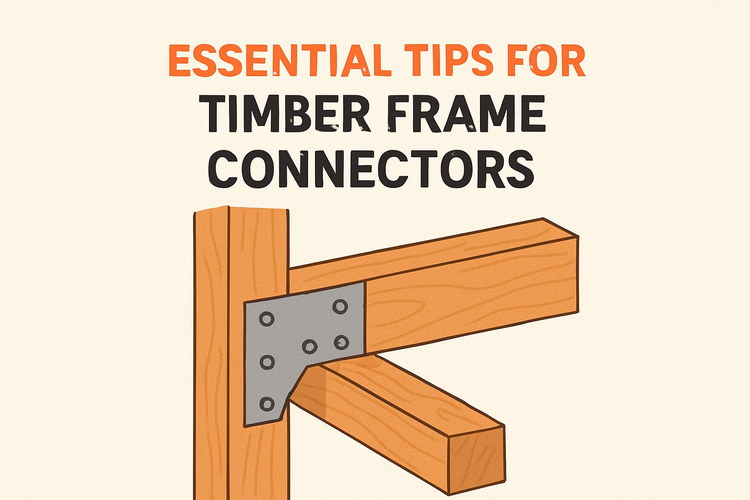Essential Tips For Timber Frame Connectors For Strong Joints

Understanding Timber Frame Connectors for Optimal Structural Strength
Timber frame connectors are crucial components in building durable and stable wooden structures. They ensure that individual timber sections are safely joined and maintain the integrity of the overall design.
Whether you're working on residential framing, a garden structure or a larger commercial project, the right connector can dramatically influence safety and performance. Choosing connectors that suit your specific timber load and joint type ensures the longevity and strength of your construction. Frequent inspection and correct installation are just as critical as selecting the right type of connector itself.
For example, timber frame connectors come in various sizes and materials to address different environments and stresses. From corrosion-resistant galvanized steel to specialty brackets for seismic zones, choosing the appropriate style ensures your structure can withstand both gravity and lateral forces.
Choose the Right Connector for the Right Joint
The effectiveness of timber frame connectors depends heavily on selecting the right one for each specific application. Using a joist hanger where a post base is needed won’t provide adequate support or load distribution.
For vertical load-bearing connections, post bases are ideal. They lift wooden posts off the ground, minimizing moisture contact and extending the life of the timber. Meanwhile, joist hangers are best for securing horizontal beams and providing consistent alignment and support. Each connector has been engineered for a specific orientation and force configuration, so always follow manufacturer guidelines.
Understanding structural load paths is also essential when choosing connectors. Load paths refer to how forces travel through a structure to reach the ground. Properly positioned connectors distribute these forces evenly and help avoid overstressed joints that can lead to failure over time.
Misapplication of connectors not only risks structural integrity but may also violate local codes. That’s why it's worth double-checking with local building regulations and code requirements before finalizing your selection of timber connectors. Safety and compliance go hand-in-hand, especially for long-term builds.
Secure Installation Techniques for Long-Lasting Joints
Using the right connector is the first step; installing it properly completes the strength of the joint. Most connector failures result from incorrect attachment methods, not inferior materials.
Always use the recommended fasteners, such as approved nails or screws, when mounting timber frame connectors. These fasteners are often designed to work specifically with the connector type and provide maximum holding capacity. Using the wrong length or gauge of screw can cause joint slippage under load, compromising the structural integrity.
Ensure flush contact between connectors and timber surfaces to promote even load distribution. Gaps can create stress concentrations that lead to premature cracking or breaking. A level surface and accurate pilot holes are essential to avoid angling fasteners and reducing their performance.
Where applicable, reinforcement using restraint straps can add an extra layer of stability, especially in high-wind areas or multi-storey constructions. These straps help fix framed elements to larger structural components and increase overall rigidity.
Combining Modern and Traditional Techniques
Modern timber connectors bring engineering precision to traditional woodworking techniques. When merged thoughtfully, they yield structures that are both beautiful and resilient.
For example, mortise and tenon joints can now be reinforced with steel angle brackets for additional load support. This hybrid approach preserves the aesthetic integrity of joinery while increasing its capacity to handle tensile and compressive forces. You don't have to sacrifice architectural charm for durability.
Innovations like connectors for glulam timber and cross-laminated timber connectors are driving design flexibility. These engineered wood products, known for their strength and sustainability, benefit from high-performance, purpose-built connectors that allow for more dramatic spans and efficient build processes. With them, architects and builders can think bigger and greener.
Adopting a balanced construction philosophy—blending craftsmanship with scientific rigor—creates timber structures that excel in both form and function. Take the time to explore how both methods can enhance your next build.
Consider Environmental Conditions and Performance Over Time
Timber structures live exposed to various climate influences, ranging from damp conditions to major wind events. Choosing connectors with longevity in mind ensures your build performs without unintended maintenance or early failure.
Look for galvanized or stainless-steel connectors, especially in coastal or damp environments, to resist corrosion. Connectors used at ground level, such as post bases, are particularly vulnerable to moisture buildup—another reason to use raised systems to prevent direct contact with soil.
Structures exposed to lateral or uplift forces should incorporate high wind ties to prevent displacement or collapse. Regular inspections should be part of the maintenance plan. Even the strongest connectors can loosen over time if not properly monitored and adjusted when needed.
Ultimately, understanding how connectors age in real-world environments allows you to make informed decisions early in your project. Smart connector selection isn’t just about achieving code compliance—it’s about building smarter, safer, and for the future.
